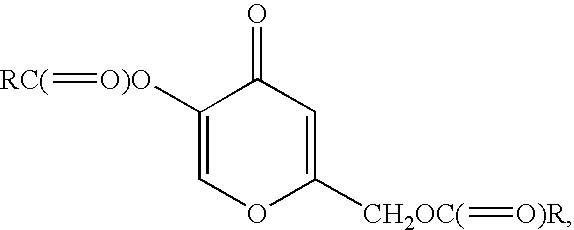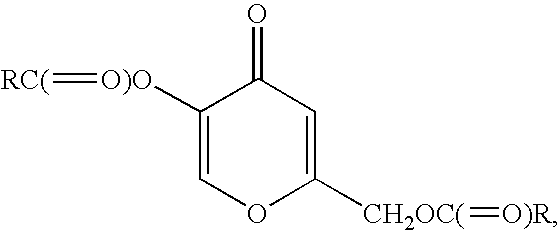Imrpoved Skin Brightening Compositions
- Summary
- Abstract
- Description
- Claims
- Application Information
AI Technical Summary
Benefits of technology
Problems solved by technology
Method used
Image
Examples
example 1
[0046]The following oil-in-water emulsion containing a combination of entrapped retinol loaded onto polymeric microparticles and free unentrapped kojic acid dipalmitate was prepared as follows:
IngredientsWt. %Phase A 1 Deionized Water63.83 2 Magnesium Aluminum Silicate0.5 3 Glycerin3 4 Na2EDTA0.2 5 Triethanolamine0.6 6 Methylparaben0.2Phase B 7 Cetyl Ricinoleate2 8 Cetyl Alcohol2 9 C10-30 Cholesterol / Lanosterol Esters2.510 Emulsifing Wax NF4.511 Dimethicone (350 cst)212 Vitamin E Acetate0.313 PEG-10 Soy Sterol0.514 Stearic Acid115 Ascorbyl Phosphate0.0516 BHT0.217 Cyclomethicone118 Caprylic / Capric Triglyceride619 Cetyl Phosphate120 PEG-100 Stearate2.521 Kojic Dipalmitate1.322 Alpha bisabolol0.1Phase C23 Microsponge Retinol Entrapment0.72 (contains about 23.5% retinol)24 Deionized Water2.525 Benzyl Alcohol126 Phenoxyethanol0.5
[0047]Manufacturing Procedure: Admix Phase A components and heat to 75° C. Combine Phase B ingredients and heat to 75° C. Add Phase B to Phase A and homogenize...
example 2
[0048]The following oil-in-water emulsion containing a combination of entrapped retinol loaded onto polymeric microparticles and free unentrapped alpha arbutin and licorice extract was prepared as follows:
IngredientsWt %Phase AWater53.09Magnesium Aluminum Silicate0.5Na2EDTA0.2NaOH (50 wt. %)0.1Glycerin3Cetearyl Glycoside0.5Phase BCetyl Ricinoleate2Glyceryl Stearate2Cetyl Alcohol3Cetyl Phosphate1.5Dimethicone, 350 cst2.5Shea Butter0.5Stearic Acid0.5Vitamin E Acetate0.1BHT0.1Cyclomethicone1.5Caprylic / Capric Triglyceride8Phase CWater5Microsponge Retinol Entrapment0.8(contains 23.5% retinol)Alpha Arbutin1Water10Butylene Glycol3Licorice extract0.01alpha biabolol0.1Euxyl 9010 (Schulke Mayr)1
[0049]Manufacturing Procedure: Mix Phase A ingredients together at 80° to 85° C. Mix Phase B ingredients together at 80° to 85° C. Add Phase B to Phase A with mixing then homogenize the phases using a high shear mixer to form an emulsion. Cool the emulsion to less than 45° C., then add the components o...
example 3
[0050]The irritation potential for the emulsion of Example 1 was compared to a commercial retinol cream that did not contain a second skin brightening agent (ROC Retinol Correxion Deep Wrinkle Cream). The commercial cream contains 0.11%, by weight, retinol, whereas the formulation of Example 1 contains 0.17%, by weight, retinol, as analyzed by HPLC. A cumulative irritation study (N=20) was conducted via a side by side analysis of the two compositions. Each composition (0.2 g) was placed on a hypoallergenic occlusive patch and each panelist wore the patch for 24 hours. At the end of 24 hours, the patch was removed by a trained technician and skin irritation, as judged by a five point scale, was determined. This process was repeated for a total of 14 days. The cumulative score was determined by adding each of the individual scores for each of the panelists. The T-Test was used to determine the P score using 95% confidence level. The results summarized in the table below show that even...
PUM
| Property | Measurement | Unit |
|---|---|---|
| Fraction | aaaaa | aaaaa |
| Fraction | aaaaa | aaaaa |
| Fraction | aaaaa | aaaaa |
Abstract
Description
Claims
Application Information
 Login to View More
Login to View More - R&D
- Intellectual Property
- Life Sciences
- Materials
- Tech Scout
- Unparalleled Data Quality
- Higher Quality Content
- 60% Fewer Hallucinations
Browse by: Latest US Patents, China's latest patents, Technical Efficacy Thesaurus, Application Domain, Technology Topic, Popular Technical Reports.
© 2025 PatSnap. All rights reserved.Legal|Privacy policy|Modern Slavery Act Transparency Statement|Sitemap|About US| Contact US: help@patsnap.com


